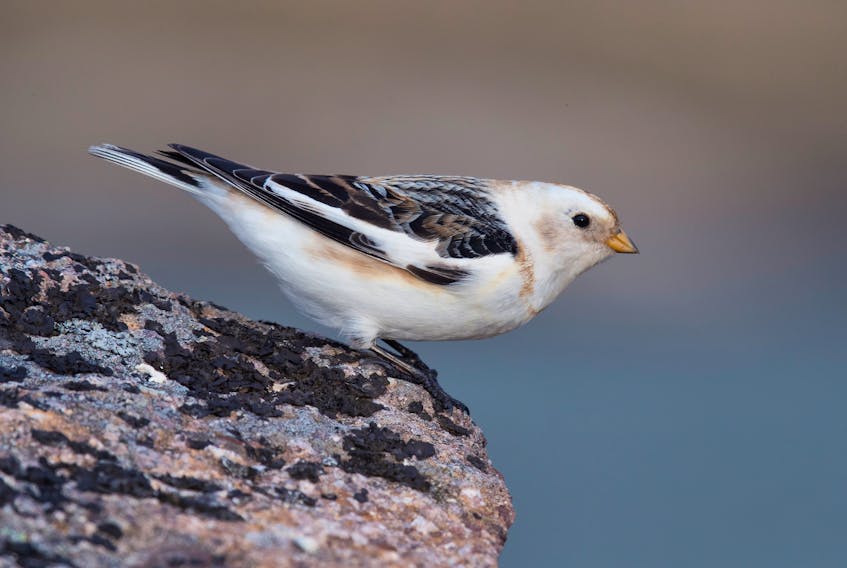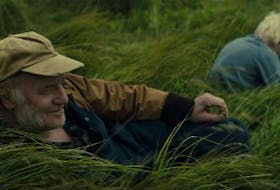Across southern Canada the robin is the iconic symbol of spring. Throughout much of the north the snow bunting takes that honour. The snow bunting nests in the Arctic barrens but spends the winter in southern Canada and the northern United States. Arctic communities offer a nesting habitat for snow buntings. They might hide their nest under some manmade structure or debris left lying on the ground and then use the roof of house for a singing perch. They have a beautiful warbled song that brightens up the early spring Arctic landscape. They are the first birds to return to the Arctic communities after a long and dark winter. Snow bunting are experts at finding seeds of grasses and other barren land plants first exposed by the rays of the spring sun on wind-blown hilltops where the snow cover was thinnest over the winter.
Snow buntings are strong for their size. Long, broad wings carry their stocky little body through the wind with confidence. They are built for the cold, windy barrens. They have an angled cutting edge to the bill allowing them to crack open the hardest of seeds. They are a social bird depending on each other to find food sources and keep an eye out for hawks. They are vocal, continually keeping contact with others in the flock.
Snow buntings also mark the arrival of spring at locations on their march northward. Residents of communities on the Northern Peninsula and Labrador see a notable migration of snow buntings starting in late March and lasting through April. The large swirling flocks are a welcome sign of spring in these areas. They occur inland at Happy Valley-Goose Bay and Wabush, but it is the coastal communities that witness the biggest movements of snow buntings. They do not hesitate to go bird feeders on their way north since most of the ground is still covered in winter snows.
This spring has been particularly cold and wintery in Labrador. The weather is stalling the northward advancement of snow buntings. Large numbers have been collecting in southern Labrador while waiting for weather conditions to improve. Vernon Buckle of Forteau on the Labrador side of the Strait of Belle Isle has been following the arrival of the snow buntings in his community. He was happy to see that 50 showed up at his bird feeder in early April, marking the start of the migration. In less than a week that numbers exploded to more than he could count swarming around his feeder. Vernon estimated there were more than 1,000 snow buntings in town. Other communities north to Nain were also getting their share of snow buntings. Anyone with a bird feeder was inundated with them.
The fall out of from the blockage of snow bunting migration has also been felt on the island of Newfoundland. There were several reports from people in central Newfoundland seeing snow buntings at their feeders for the first time. At Cape Spear near St. John’s — where you would be lucky to see a handful of snow buntings during the spring — there is a flock of 50 feeding on seed that people are throwing out for them in the parking lot. The show must go on. The weather will break soon enough and then they will be gone. Enjoy them now if you are lucky enough to be seeing them.
Other spring migrants
Fox sparrows arrived on time with the first wave hitting most of the island during the first week of April. With the snow cover in western Newfoundland many people were blessed with visits from the pretty fox sparrow. It is great to hear their song in the woods. Robins are also everywhere now. There are a lot more robins around now than over wintered here. Gannets are back at Cape St. Mary’s. Horned larks are back on the coastal barrens.
There are still great egrets and great blue herons left over from that unusual influx resulting from a southern storm in late March. It is hard to keep track of them all on the Burin Peninsula. Sue Kelland-Dyer has been keeping tabs on a great blue heron making the rounds in her area at Pt. La Haye.
A great egret is slowing down traffic on the highway through Biscay Bay as it feeds in a roadside pond. Branch is hosting two great egrets, a great blue heron and a remarkable three snow geese.
Joe Dillon was delighted to see the return of yellow-bellied sapsucker to his maple trees in St. Mary’s only to see a hawk swoop in and knock it to the ground and then fly off with it. Even visiting birds have to be cautious of the sharp-shinned hawks prowling our neighbourhoods.
It is spring, and things are happening in the world of birds.
Bruce Mactavish is an environmental consultant and avid birdwatcher. He can be reached at [email protected]









